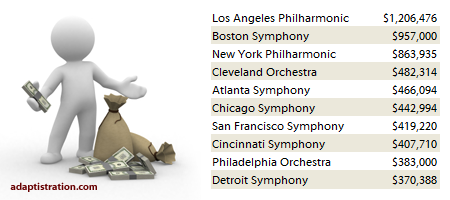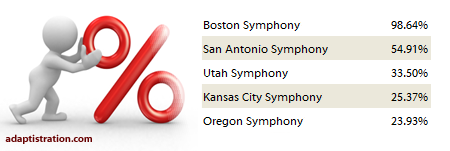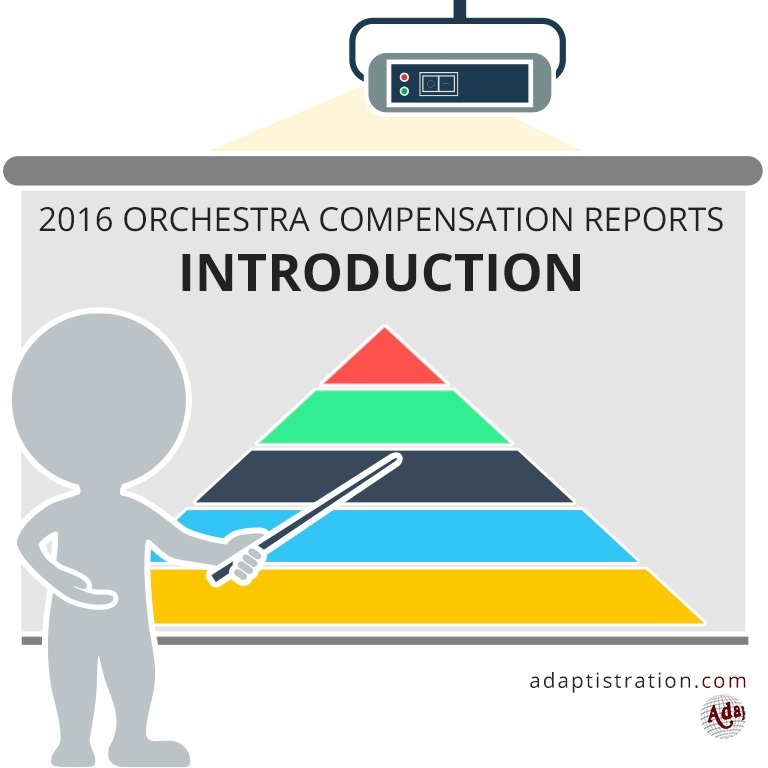If you were the CEO or Executive Director for an ICSOM orchestra in the 2006/07 season, odds are you enjoyed a sizeable increase in compensation. Not entirely unlike for profit executives in that period (but certainly not to the same degree), orchestra executive compensation skyrocketed during this time when most orchestras in the business had stabilized finances following the economic downturn following 9/11 (or so they thought).
WHERE THE DATA COMES FROM
In order to provide information that is as accurate as possible, data from the 2006/07 season is gathered from the following sources:
- Executive compensation figures were obtained from their respective orchestra’s IRS Form 990 for the 2006/07 concert season.
- Total Expenditures were also obtained from each respective orchestra’s IRS Form 990 for the2006/07 concert season.
- Base Musician compensation figures were obtained from records collected by the American Federation of Musicians and International Guild of Symphony, Opera, and Ballet Musicians (Seattle) for the 2006/07 concert season.
Adaptistration makes no claim to the accuracy of information from documents compiled or reported by external sources. If you have reason to believe any of the information is inaccurate or has changed since reported in any of the above sources and you can provide documentation to such effect, please feel free to submit a notice.
WHAT THE NUMBERS DON’T SHOW
It is important to remember that the numbers shown do not always convey a complete compensation picture. For example, an orchestra executive may have had a large increase in salary due to a contractually mandatory severance or deferred compensation package when the position was vacated. Additionally, the documents used to gather this data do not indicate how much of the season an individual received a salary. As such, the cumulative compensation may artificially inflate annual earnings. Conversely, reported figures may not reflect bonuses or other incentive payments and may therefore underreport what executives actually earn; therefore, the cumulative compensation for executive directors may or may not be more than what is listed.
The “Base Musician” compensation figures do not include any additional payments including, but not limited to, outreach services and minimum overscale and/or seniority payments. Finally, these figures do not include any of the opera, ballet, or festival orchestras which are members of ICSOM or IGSOBM.
NEW FEATURE: REAL AVERAGES
To date, each year of the Orchestra Compensation Report has provided overall increases and/or decreases in average compensation; however, those figures don’t provide an entirely accurate picture. For example, factoring in compensation data from orchestras that did not pay an executive for an entire season or paid an incoming and outgoing executive in the same season can easily skew that average up or down. As such, this year’s report introduces the average change in compensation from one season to the next using “real averages,” which are based on figures that filter out incomplete compensation records.
When these filters are applied to executive compensation for the 2006/07 season, the data indicates that the average executive serving a full season of employment enjoyed double digit increases in compensation, as illustrated in the chart below.

Due to the nature of work contracts for base musicians, a real average gap is not applicable. Consequently, from the 2005/06 to 2006/07 season, the average ICSOM executive enjoyed a rate of increase in compensation that was nearly eight-and-a-half times greater than the average orchestra musician. Furthermore, during this same period, the 13.17 percent increase in real average executive compensation was nearly double the average increase in total expenditures among all of the ensembles included in this report.
TOP EARNERS AND QUICK FACTS


- For the fourth year in a row, one executive’s compensation exceeded the $1,000,000 mark, indicating that the era of million dollar orchestra executives has arrived.
- 40 percent of the Top 10 highest paid executives for the 2006/07 season were women, including the highest paid executive.
- The average annual compensation for the Top 10 highest paid executives for the 2006/07 season was $591,993 which was a 13.44 percent increase from the previous season.
- Not unlike the sizeable increase for one CEO from two seasons ago, Boston Symphony’s Mark Volpe’s increase included the following note: “The compensation listed for Mark Volpe for the period September 1, 2006 through August 31, 2007 Includes a base salary of $460,000 as well as retroactive salary payments of $111,000 made in January 2007 for annual salary increases effective September 1,2003 (3.8%), September 1,2004 (3.6%),September 1,2005 (3.5%) and September 1,2006 (3.4%) During this year the BSO implemented a retirement compensation plan for Mr. Volpe in recognition of his 10 years of outstanding service to the organization. The plan is designed to provide Mr. Volpe an annual retirement benefit at age 60 equal to approximately 40% of the average compensation earned during his last 5 years of employment. An Irrevocable portion of this benefit will be accrued and paid each year that he is employed. His current compensation (Column C) Includes $357,471 which represents a one time catch up adjustment and the current year obligation The projected benefit to be expensed and paid In fiscal 2008 IS $64,000.“
ARE WE COMPENSATING EFFORT OVER ACHIEVEMENT (AGAIN)?
The predecessor to the Orchestra Compensation Reports is a shorter series of articles from April, 2004 entitled Are We Compensating Effort Instead Of Achievement? At that point in time, the orchestra business was just beginning to come to terms with the financial fallout from 9/11 and economic pundits throughout the country were starting to question the rate of increase in compensation for U.S. executives compared to workers in light of record corporate profits.
Perhaps unsurprisingly, the recent economic downturn has offered levels of transparency that indicate much of those economic gains were, to large measure, artificial. Consequently, it seems reasonable to conclude that the orchestra business would be wise to reevaluate methods used to set executive compensation. The old mantra of “keeping up with the for profit sector” rings somewhat hollow these days when crafting compensation schedules and much like the economic environment after 9/11 where crisis promoted hard work, boards need to be on guard against compensating effort over achievement.
To this end, it would wise for boards throughout the country to consider using outside resources to help set and evaluate executive compensation. Furthermore, to avoid the “letting the fox into the hen-house” conflict of interest, outside assistance should exclude the services of recent orchestra executives as well as organizations staffed by those same individuals.
CAN EQUAL BE UNEQUAL?
The 5/17/2009 edition of the Chicago Tribune published an article by John von Rhein wherein he espouses a system of shared pain when it comes to instituting salary cuts. Likewise, the very same notion was presented here at Adaptistration as a recommend practice in an article from January, 2009 entitled A Meaningful Approach To Concessions.
Nonetheless, orchestra stakeholders would be wise should examine proposed or recently implemented salary cuts at their respective organization from a dynamic perspective. For instance, if an orchestra’s CEO and musicians agreed to take an identical reduction in compensation it is fair to examine the past several years of changes in compensation in order to determine exactly what constitutes as “identical.”
Take, for example, the recent cuts instituted by the Phoenix Symphony Orchestra. In a press release from 5/19/2009, the organization promotes the fact that musicians and the CEO agreed to accept an equal pay cut, which is evidence that the “Institution [united] to battle [the] impact of recession and challenges.”
However, between the 2003/04 and 2006/07 seasons, the organization’s CEO experienced an average increase in compensation of 5.27 percent while during the same period the average increase in base musician compensation was 3.37 percent. Although the 2007/08 and 2008/09 CEO compensation data is unknown (base musician compensation during these seasons were 7.85 percent and 3.96 percent, respectively), this historical perspective indicates the CEO enjoyed a higher rate of increase in compensation over the past several years as compared to musicians.
Ultimately, the organization’s stakeholders will need to determine if this historical perspective has any impact on whether or not the purported equal pay cut is indeed, equal (and this doesn’t take into account any deferred compensation that may or may not be included in the CEO’s employment contract, but that’s a worthwhile issue to include). If nothing else, this situation, along with all others throughout the business, is a representative example behind the value of institutional transparency.




2 thoughts on “2009 Compensation Report: ICSOM Executives”